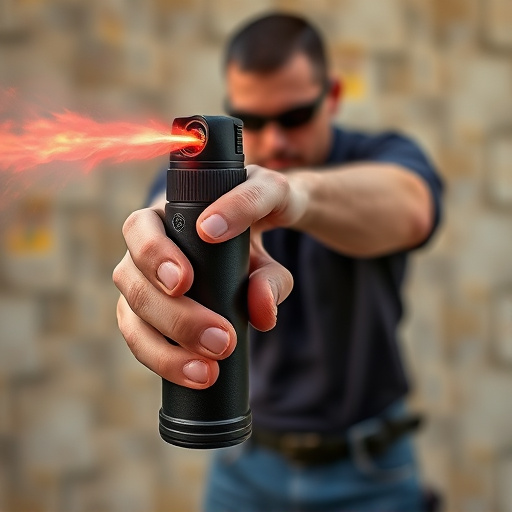To legally carry pepper spray, understand regional age restrictions, regulations on quantity and storage, and conditions for usage. Stay informed through official resources or legal experts. Store it securely, keep it out of children's reach, practice regular usage, and be mindful of wind direction and surrounding individuals. Regularly check expiration dates, maintain canisters, test functionality, and familiarize yourself with local laws to ensure responsible use within legal boundaries.
“Uncover the power of pepper spray as a personal defense mechanism, a tool that can provide vital protection in potentially dangerous situations. This comprehensive guide explores how to legally carry pepper spray, covering key considerations and best practices. From understanding its effectiveness against assailants to ensuring safety precautions during use, we delve into the responsible ownership and deployment of this deterrent. Learn the do’s and don’ts of storage and maintenance to maximize its reliability when you need it most. Discover how to legally carry pepper spray with confidence.”
- Understanding Pepper Spray as a Defense Mechanism
- Legal Considerations for Carrying Pepper Spray
- Effective Use and Safety Precautions
- Best Practices for Storage and Maintenance
Understanding Pepper Spray as a Defense Mechanism
Pepper spray, officially known as oleoresin capsicum (OC) spray, is a non-lethal self-defense mechanism that uses capsaicin, the active ingredient found in chili peppers, to cause temporary disorientation and pain. When deployed, pepper spray irritates the eyes, nose, throat, and skin, leading to temporary blindness, coughing, and difficulty breathing. This disruption buys time for the user to escape a potentially harmful situation.
To legally carry pepper spray for self-defense, individuals must understand and adhere to local laws and regulations. The age restrictions vary across regions, with many requiring users to be 18 or older. Additionally, there are rules regarding where and how much spray can be carried, as well as specific conditions under which it can be used. Knowing and respecting these legal boundaries is essential for responsible pepper spray ownership and effective self-defense.
Legal Considerations for Carrying Pepper Spray
The legalities surrounding pepper spray ownership and carrying vary significantly across jurisdictions, making it crucial for individuals considering this self-defense mechanism to understand their region’s specific laws. While some areas permit citizens to carry pepper spray for personal protection, others have stringent regulations or outright bans. In many places, obtaining a permit is mandatory, requiring individuals to demonstrate a valid reason for ownership and undergo training in its safe use. The age restriction also plays a significant role; in some countries, only adults over a certain age are permitted to carry pepper spray legally.
Understanding these legal considerations is essential when exploring how to legally carry pepper spray. Individuals must research their local and national laws to ensure compliance and avoid potential legal repercussions. This process involves consulting official government resources or seeking advice from legal experts to stay informed about any updates or changes in regulations, ensuring personal safety while adhering to the law.
Effective Use and Safety Precautions
To effectively utilize pepper spray as a deterrent or for self-defense, it’s crucial to understand how and when to deploy it legally and safely. First, ensure that you are in an area where carrying pepper spray is permitted by local laws. Know your rights and the regulations regarding self-defense tools, including any restrictions on the type and amount of pepper spray allowed.
Safety precautions are paramount. Always keep pepper spray out of reach of children and store it in a secure location. Familiarize yourself with the spray’s functionality; know how to activate it quickly and accurately. Regularly practice its use to ensure you can deploy it effectively when needed. Additionally, be mindful of wind direction and surrounding individuals to minimize potential harm to bystanders or yourself.
Best Practices for Storage and Maintenance
When it comes to storing and maintaining pepper spray, safety is paramount. Always keep it in its original packaging with labels intact for easy identification. Store it in a cool, dry place away from direct sunlight and heat sources, as extreme temperatures can affect the spray’s potency. Ensure it’s locked up and out of reach of children or unauthorized individuals to prevent accidental use. Regularly check the expiration date and discard any outdated spray, as its effectiveness diminishes over time.
Proper maintenance involves keeping the canister intact and undamaged. Avoid excessive force when opening or closing the nozzle. Store spare refills separately, ensuring they are also in good condition. Periodically test the spray by releasing a small burst to ensure it functions correctly. Familiarize yourself with local laws regarding pepper spray possession and how to legally carry it, as these regulations vary by region. This ensures you use it responsibly and within legal boundaries.
Pepper spray can be an effective personal defense mechanism when used properly. Understanding its application, legalities, and safety measures is crucial. By learning how to legally carry pepper spray and following best practices for storage and maintenance, individuals can enhance their personal security. Always stay informed about local regulations and use these tools responsibly to ensure your safety without causing harm to others.
